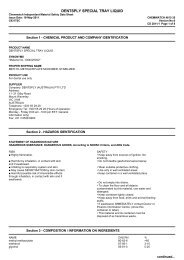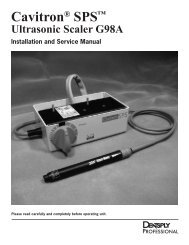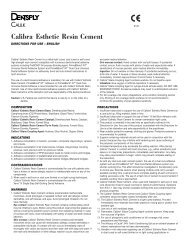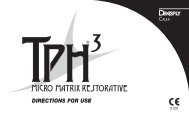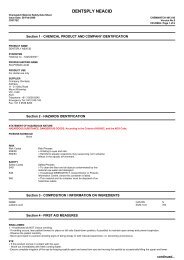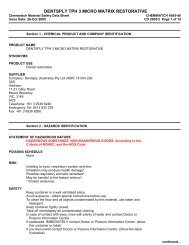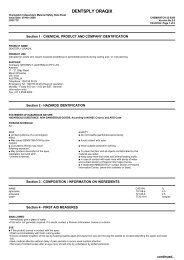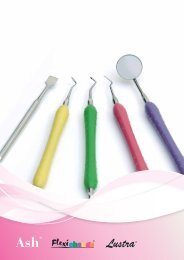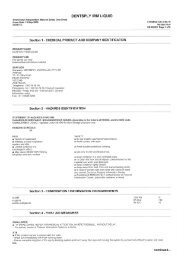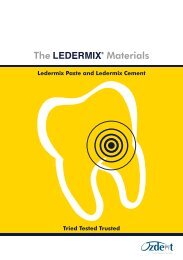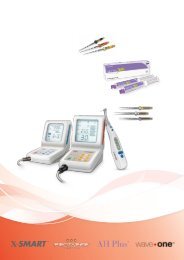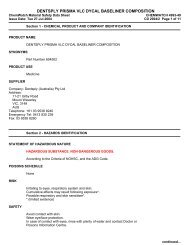105883-40-7
105883-40-7
105883-40-7
You also want an ePaper? Increase the reach of your titles
YUMPU automatically turns print PDFs into web optimized ePapers that Google loves.
DENTSPLY PROBOND PRIMER<br />
Chemwatch lndependent Mater¡al Safety Data Sheet<br />
lssue Date:8-Ocþ2009 CHEMWATCH 4613-30<br />
C9317TC<br />
Version No:5<br />
CD 2009/3 Page 2 of 6<br />
Section 4 - FIRST AID MEASURES<br />
EYE<br />
r lf this product comes in contact with the eyes:<br />
- lmmediately hold eyelids apart and flush the eye continuously w¡th running water.<br />
- Ensure complete irrigation of the eye by keeping eyelids apart and away from eye and moving the eyelids by occas¡onally lifting the upper and lower<br />
lids<br />
SKIN<br />
I lf skin or hair contact occurs:<br />
- Flush skin and hair with running water (and soap if available)<br />
- Seek medical attention in event of irritation.<br />
INHALED<br />
r - lf fumes or combustion products are inhaled remove from contaminated area<br />
- Lay patient down Keep warm and rested.<br />
NOTES TO PHYSICIAN<br />
r Any material aspirated during vómiting may produce lung injury. Therefore emesis should not be induced mechanically or pharmacologically.<br />
For acute or short term repeated exposures to acetone:<br />
- Symptoms of acetone exposure approximate ethanol intoxication.<br />
- About 20% is expired by the lungs and the rest is metabolised. Alveolar air half-life is about 4 hours following two hour inhalation at levels near<br />
the Exposure Standard; in overdose, saturable metabolism and limited clearance, prolong the elimination half-life to 25-30 hours<br />
For acute or short term repeated exposures to ethanol:<br />
- Acute ingestion in non-tolerant patients usually responds to supportive care with special attention to prevent¡on of aspiration, replacement of<br />
fluid and correction of nutritional deficiencies (magnesium, thiamine pyridoxine, Vitamins C and K).<br />
- Give 50% dextrose (50-100 ml) ¡V to obtunded patients following blood draw for glucose determination<br />
Section 5 - FIRE FIGHTING MEASURES<br />
EXTINGUISHING MEDIA<br />
r - Alcohol stable foam<br />
- Dry chemical powder.<br />
FIRE FIGHTING<br />
r - Alert Fire Brigade and tell them location and nature of hazard.<br />
- May be violently or explosively reactive<br />
FIRE/EXPLOSION HAZARD<br />
r - Liquid and vapour are highly flammable<br />
- Severe fire haza¡d when exposed to heat, flame and/or oxidisers.<br />
Combustion products include: carbon dioxide (C02), carbon monoxide (CO), other pyrolysis products typical of burning organic material.<br />
lVay emit poìsonous fumes.<br />
FIRE INCOMPATIBILITY<br />
r - Avoid contamination with oxidising agents ie nitrates, oxidising acids, chlorine bleaches, pool chlorine etc. as ignit¡on may result<br />
HAZCHEM: e3YE<br />
PERSONAL PROTECTION<br />
Glasses:<br />
Full face- shield.<br />
Gloves:<br />
PVC chemical res¡stant type<br />
Respirator:<br />
Type AXNO Filter of sufficient capac¡ty<br />
Section 6 - AGGIDENTAL RELEASE MEASURES<br />
MINOR SPILLS<br />
r - Remove all ignition sources<br />
- Clean up all spills immediately.<br />
MAJOR SPILLS<br />
r - Clear area of personnel and move upwind.<br />
- Alert Fire Brigade and tell them location and nature of hazard.<br />
Personal Protective Equipment advice is contained in Section I of the MSDS.<br />
cont¡nued...




